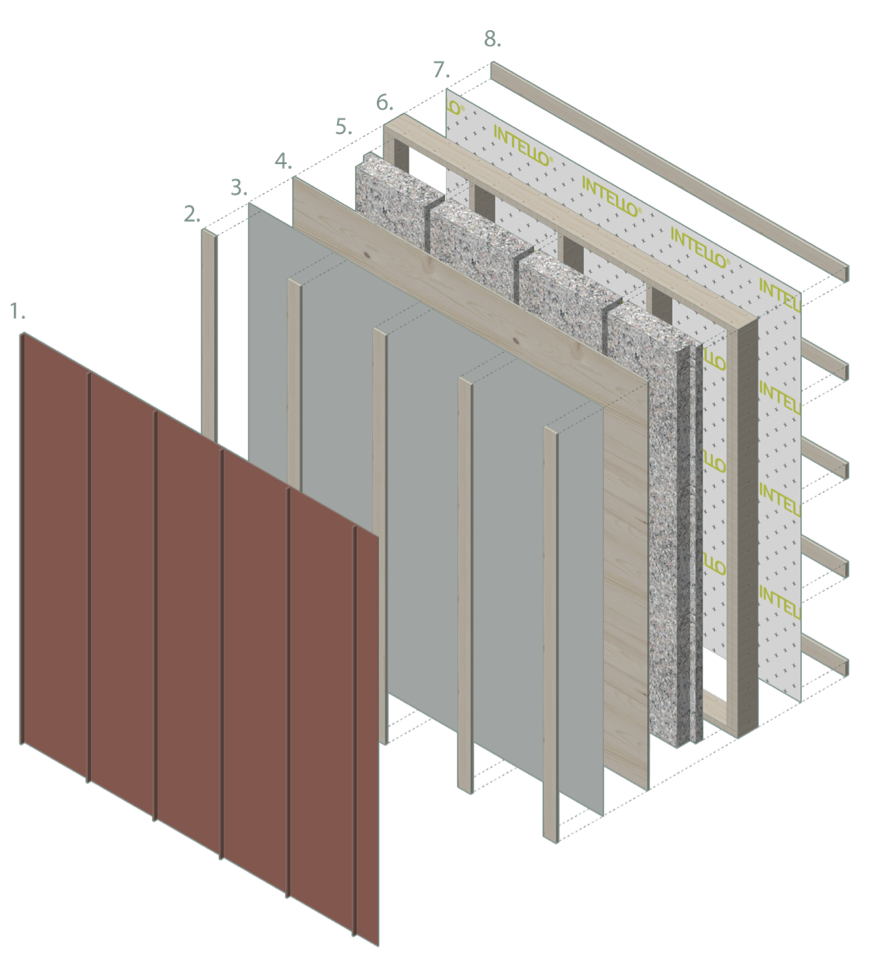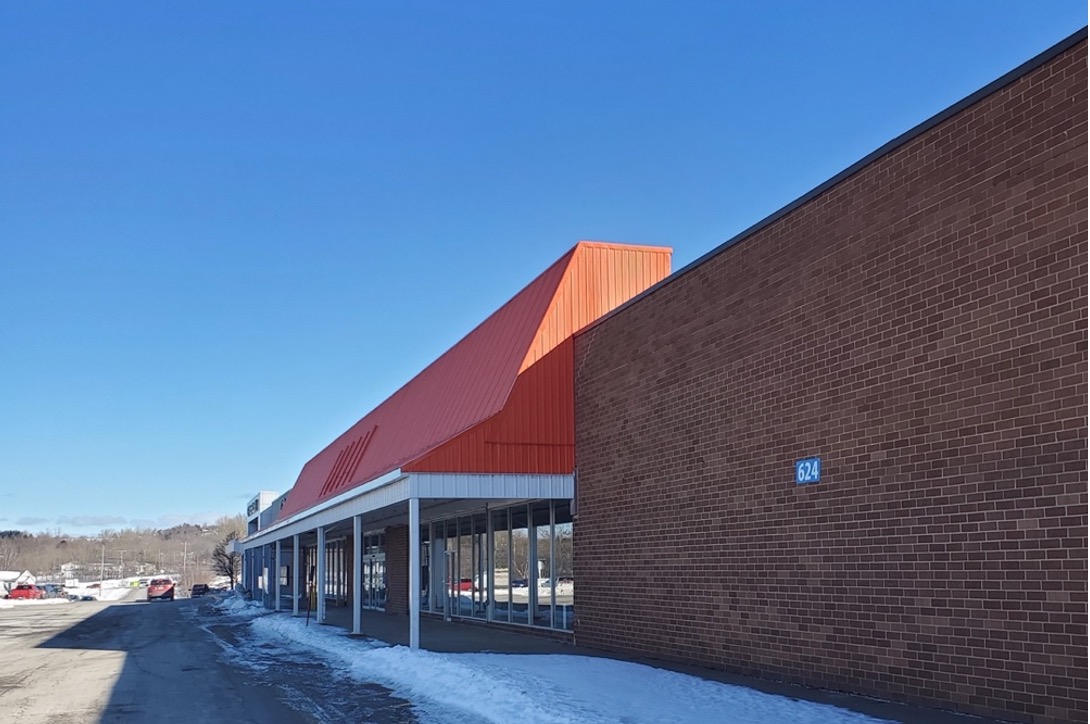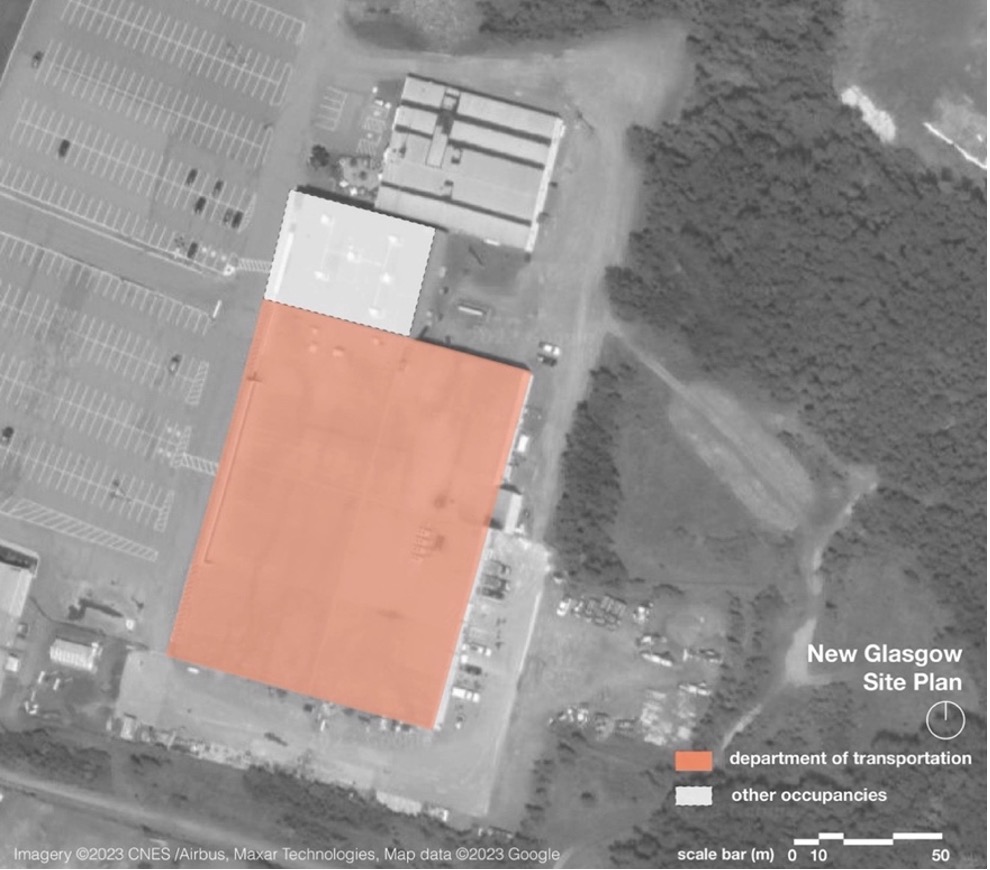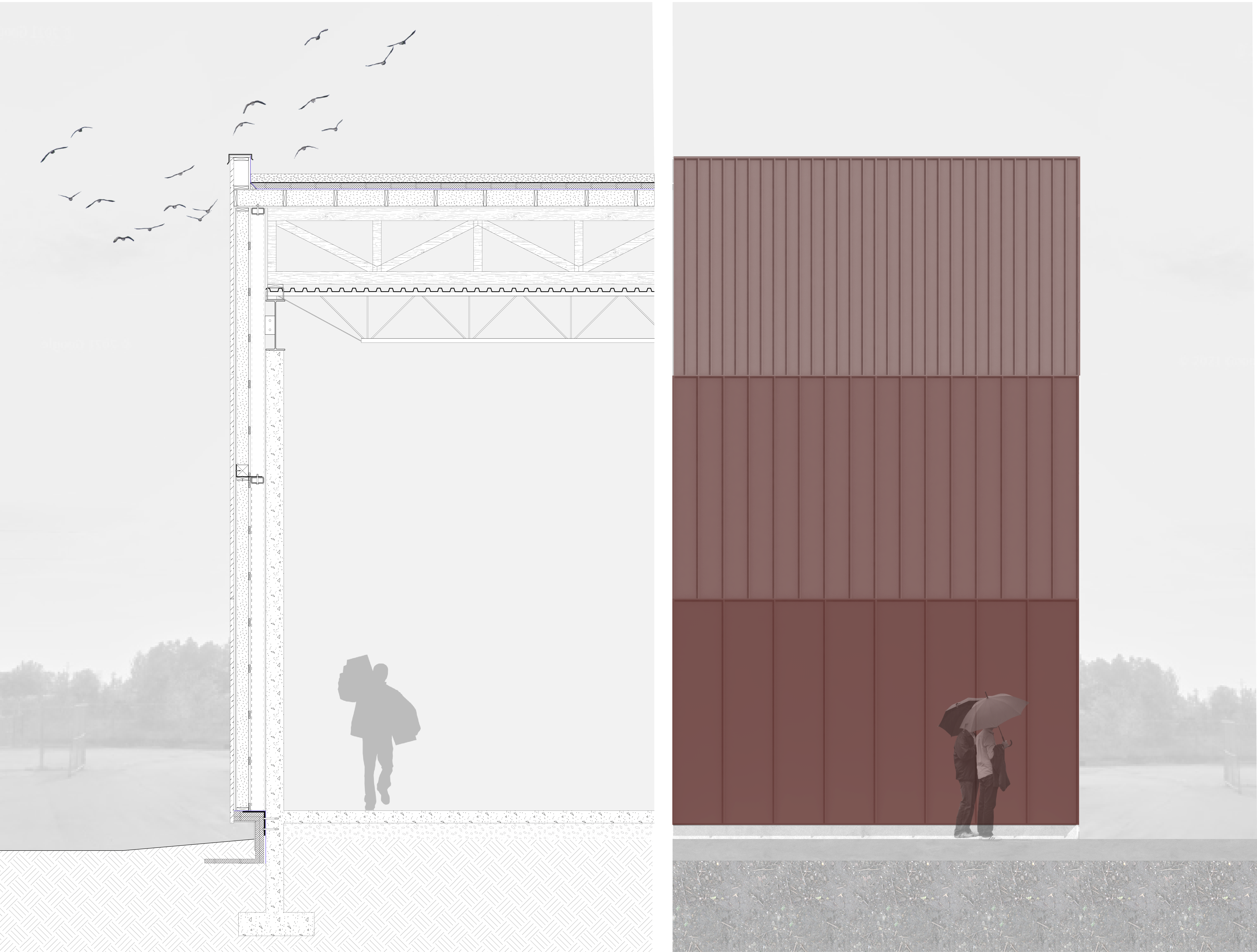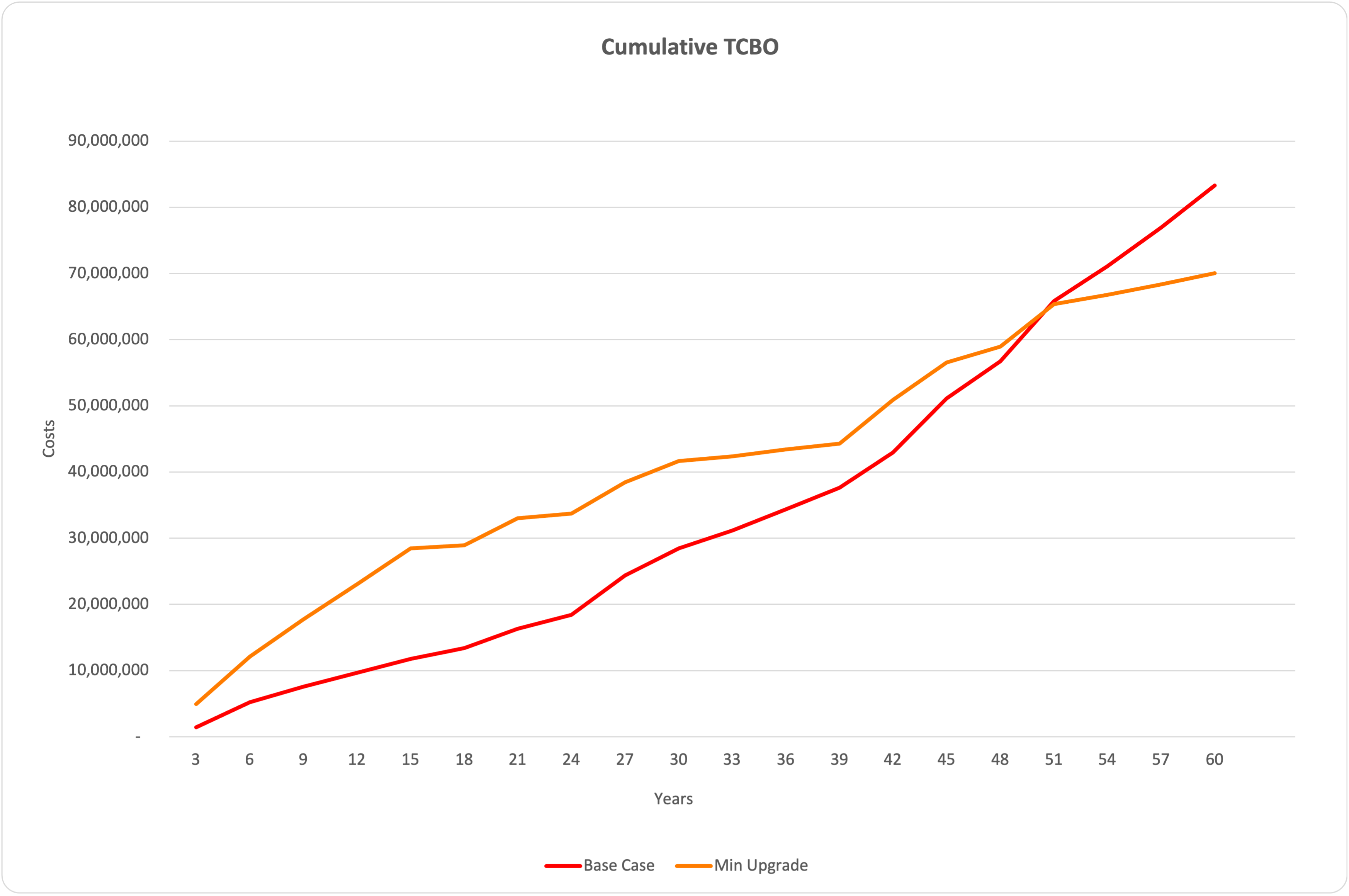New Glasgow Municipal Operations Building Retrofit – Feasibility Study
This case study, submitted by the ReCover Initiative, outlines a net-zero scenario using a panelized deep retrofit solution for a municipal operations building built in 1987.
| Building Type | Part 3 | Location | New Glasgow, NS |
| Year Built | 1976 | Structure Type | Concrete Block |
| Total Floor Area | 7430m2 | Climate Zone | 6 |
| Heating Degree Days | 4320 |
Project Team
- Habit Studio Energy Modelling ( Designer or Architect )
- RDH ( Energy Modelling )
- M&R Engineering ( Electrical and Mechanical Engineer )
- Stanley Francispillai ( Hygrothermal )
- Seefar Building Analytics ( Financial Model )
- QSolv ( Cost Consultant )
- Fatma Osman ( Embodied Carbon Modelling )
- Natural Resources Canada, The Atmospheric Fund, Nova Scotia Department of Natural Resources and Renewables, City of Burlington, Municipality of Colchester, Halifax Regional Municipality, Town of New Glasgow, City of Oakville, City of Saskatoon ( Funders )
Project Priorities
- Reduce Energy Consumption
- Achieve Net Zero or Net Zero Ready
- Reduce GHG Emissions
- Other
Project Goals
The objectives of this study were to de-risk investment in deep retrofits in Canada, to provide evidence on the effectiveness and scalability of a panelized deep retrofit approach and to build confidence and experience in deep retrofits among Canadian municipalities and industry stakeholders.
The goals for the Deep Retrofits explored included:
- Develop a scenario that achieves an Energy Use Intensity (EUI) reduction of 50%.
- Develop a Net Zero Energy Ready (NZER) scenario.
- Develop a Net Zero Energy (NZE) scenario with the addition of onsite renewables.
- All solutions minimize occupant disruption during construction.
- All solutions target minimal embodied carbon.
- Identify the retrofit pathway to the lowest Total Cost of Building Ownership.
- Demonstrate a calculated payback of 20 years or better.
Project Description
Planning the Retrofit
Existing Building Details
Overview
The New Glasgow Municipal Operations Building is a one-storey steel structure with a gross floor area of 7,430m2 (80,000 sq. ft). The space is divided into two areas, a 5,670 m2 retail space at the front of the building, which is presently unoccupied, and a 1,760m2 space at the back used by the New Glasgow Public Works and Engineering Department. The facility is used as a maintenance shop for storage and servicing of New Glasgow’s fleet of trucks, snowplows, and other heavy machinery. It also contains office space, storage rooms, washrooms, and service spaces. The north wall of the building is partially shared with an adjacent movie theatre.
Prior to the start of this study the town of New Glasgow had initiated a preliminary plan to retrofit the building to address necessary upgrades and to convert a portion of the unused space to administrative use.
The building was originally built as a K-Mart box store in 1976. It is in a commercial area of New Glasgow with nearby forested areas. The building has been used by the Department of Engineering and Public works since 2012. The retail area of the building was used as a weekend Flea Market prior to the COVID-19 pandemic.
In 2022 the Town of New Glasgow implemented their community climate action plan which targets 50% reduction in community GHG emissions and 30% reduction in Municipal GHG emissions below 2018 levels by 2030. Acting on emissions from buildings is one of five focus areas in the plan.
Existing Envelope
The walls of the Municipal Operations Building consist of 200mm (8”) concrete block. On the south, west elevations and exposed portion of the north wall, the wall has 25mm (1”) rigid insulation and brick cladding. There is interior drywall finish in some areas and exposed concrete block elsewhere. The east (rear) wall has no finishes or insulation.
The roof is an uninsulated corrugated metal roof deck with a modified bitumen roof system. The concrete slab-on-grade floor and cast in place concrete foundations are also uninsulated. Windows are single glazed aluminum storefront units and are concentrated on the west wall.
Existing Structure
The building consists of structural steel columns and beams that support an open web steel joist (OWSJ) and corrugated steel deck roof system. Details on the steel strength and weld connections is unavailable, and analysis was based historic steel strengths and the construction date.
Modeling indicates that most of the primary steel structure can support the post-retrofit loads but reinforcement of some columns and beams may be necessary. The OWSJs can’t support added loading. Verification of the steel strength and connection details must be done prior to construction.
The exterior walls of the building are 200 mm (8”) thick concrete block. These serve as part of the lateral load resisting system (LLRS) and do not support the roof. Various penetrations have been made in the masonry over the years and there are cracks in the walls and at openings. There is no visible grout or reinforcing in the blocks.
Existing Electrical and Mechanical
| Primary Heat Source | Oil Fired Boiler |
| Heat Distribution | Hydronic Baseboard + Unit Heaters |
| Cooling Source | 34 Ton RTU |
| Electrical Service | 100A and 200A connection to grid |
| Electrical Distribution | 800A 3p |
| Interior Lighting | Fluorescent Fixtures |
Existing Energy Use (KWH/M2/YR)
| Lights | 9.55 |
| Plug Loads | 7.70 |
| Electric Heat | 3.40 |
| Cooling | 0.11 |
| Pump | 1.00 |
| Fans | 6.17 |
| Elec DHW | 0.47 |
| Fuel Oil | 107.75 |
Upgrade Scenario
The design team worked collaboratively to develop retrofit scenarios targeting the project objectives. The analysis assumes a ‘like for like’ retrofit where space usage, occupancy schedules, internal geometry, volume of conditioned space, and window and door dimensions and locations are consistent with existing conditions.
The strategy for building enclosure upgrades includes prefabricated ReCover panels installed on both the walls and roof.
| Existing Building | Min + Solar | |
|---|---|---|
| Effective Wall R-Value | R3.8 | R14 |
| Effective Roof R-Value | R0.7 | R18 |
| Windows | Vinyl, Single Glazed, R2.5 | Triple Pane R5.56 |
| Air Tightness | 3.0 L/s m² | 0.5 L/s m² |
| Heating Source | Oil Fired Boiler | Existing Oil Fired Boiler with Modulating Burner |
| Heating Distribution | Unit Heaters, AHU, Electric Baseboards | Existing Unit Heaters, AHU, Electric Baseboards |
| Cooling | Mini Split and AHU | Existing Mini Split and AHU |
| DHW | Electric Water Heater | Existing Electric Water Heater |
| Ventilation Equipment | Exhaust Fan and AHU | 90% SRE ERVs |
| Electrical Service | 800A, 3p | Existing 800A, 3p |
| Renewable | None | None |
| 60 Year TCBO | $83,302,000 | $73,947,000 |
Panelized Solutions
The prototype ReCover panel is a wood framed box which holds carbon storing cellulose insulation. The depth of the frame is flexible depending on the needed performance.
The panel components were specified to minimize moisture risks by shedding precipitation on the outside and by promoting drying activity to the exterior through the panel assembly. This is important as the existing assemblies include vapour retarding materials, including polyethylene vapour barrier and rigid foam insulation, which will inhibit drying to the interior of the building. These materials will also inhibit outward vapour drive, from the interior into the panels, however given the age and condition of the building it is highly unlikely that these materials comprise a continuous vapour barrier. The panels are be designed to promote any moisture movement that occurs from the interior to dry to the exterior.
Strapping on the interior side of the panel permits fitting adjustments against the existing walls and provides an internal air cavity that serves as a moisture buffer space for vapour diffusion from the inside to pass out through the panels. The frame backing layer is a “smart” vapour control membrane which varies in permeability depending on the relative humidity of its environment. If moisture is present between the panel and the existing walls the membrane fibers open to let moisture escape. Wood panel framing, plywood sheathing and cellulose insulation are all hygroscopic materials, meaning their fibers transport moisture from areas of higher humidity to those of lower humidity. A vapour-open water-resistive barrier (WRB) protects the outer plywood sheathing and provides a drainage plane behind the rainscreen cavity and metal siding.
Wall Panel Details – PDF | Wall Panel Details – Sketchup | Roof Panel Details – PDF | Roof Panel Details – Sketchup
Embodied Carbon
Embodied Carbon was modeled for this project in One Click LCA. Materials modeled were based on the most representative materials available to the Canadian market with Environmental Product Declarations (EPDs) available in the One Click LCA database. The analysis was limited to embodied carbon of assembly materials being added to the building including panel additions to above-grade walls, roofs, below-grade components, and windows and doors. HVAC and electrical components were excluded from the analysis.
The results include a whole life cycle assessment of the building in six impact categories: Global Warming, Ozone Depletion, Acidification, Eutrophication, Formation of tropospheric ozone, Depletion of nonrenewable energy, and Biogenic carbon storage.
Total Cost of Building Ownership (TCBO)
Total Cost of Building Ownership (TCBO) analysis was conducted using the Sustainable Energy Efficient Facility Asset Renewal (SEEFAR)-Valuation© program. Calculations include costs for utilities, insurance, carbon tax, maintenance, maintenance capital (replacing major components as they age out), interest, and escalation of these costs over time. TCBO analysis typically includes property taxes, however the building is not subject to property tax.
TCBO Summary
| Base Case | Min Upgrade | |
|---|---|---|
| GHG Emissions (kg) (60 Years) | 33,263,379 | 10,315,774 |
| EUI (kWh/m²/year) | 248.6 | 56 |
| TCBO at 60 Years | $83,302,000 | $70,019,000 |
| TCBO Savings at 60 Years | $0 | $13,283,000 |
| % Diff. from Base Case | – | 16% |
Cumulative TCBO
The lowest TCBO is the Minimum Upgrade with a 16% reduction in TCBO and a savings of $13.3M. However, this analysis does not include the costs associated with eventual electrification of the Minimum Upgrade between now and 2050.
After 51 years the savings in operating costs from doing the retrofit will exceed the business as usual scenario.

